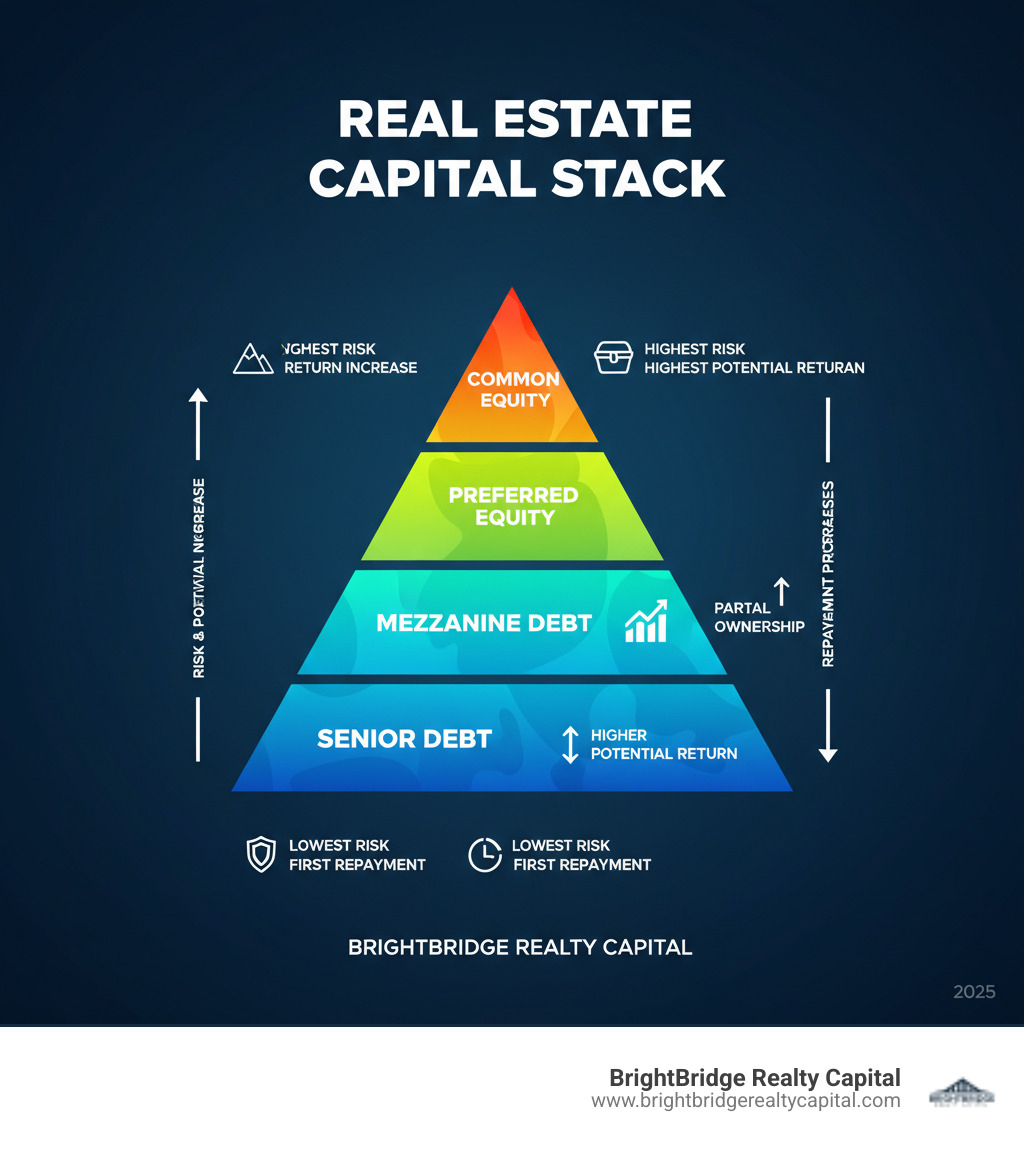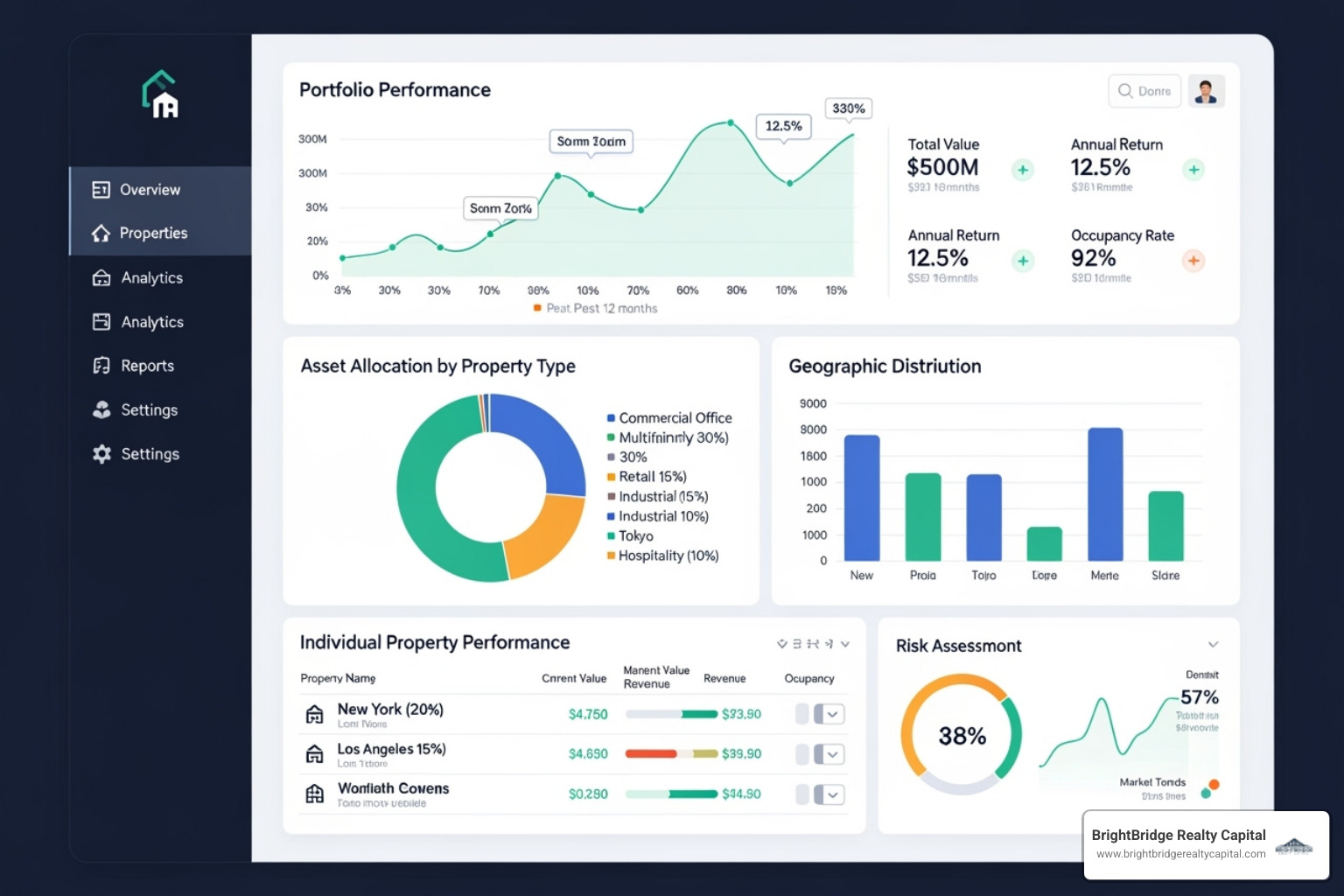Funding Your Empire: Essential Real Estate Capital Strategies

Why Understanding Capital for Real Estate is Critical to Your Success
Capital for real estate is the money you need to acquire, develop, and operate properties. Knowing how to access it determines whether your investment goals stay on paper or become reality.
Quick Answer: Top Funding Options for Real Estate Investors
- Traditional Mortgages – Long-term bank loans with strict qualifications.
- Private Money Lenders – Fast, flexible loans based on asset value.
- Bridge Loans – Short-term financing to bridge funding gaps.
- Home Equity Loans (HELOC) – Use equity in existing property to fund new deals.
- REITs – Passive, low-cost entry into real estate.
- Syndication/Joint Ventures – Partner to fund larger projects.
Real estate investing isn't just about finding the right property; it's about finding the right money at the right time. The capital you choose shapes your risk, returns, and timeline. Most investors start by asking how much they need, which depends on the strategy—a REIT may cost $1,000, while a rental property could require $100,000 or more. But capital is more than the upfront cost; it's about understanding debt vs. equity, when to leverage or partner, and avoiding mistakes that drain cash flow.
I'm Daniel Lopez, a loan officer at BrightBridge Realty Capital. I help investors structure capital for real estate deals that accommodate tight timelines and unique properties. In this guide, I'll walk you through the funding strategies that work so you can move fast and build your portfolio.

Capital for real estate basics:
Understanding the Building Blocks: What is Real Estate Capital?
Capital for real estate is the money required to make a deal happen and keep it running. It covers not just the purchase price but everything needed to turn an idea into an income-producing asset. This includes acquisition funding to buy the property, development costs for construction and permits, and ongoing operating expenses like taxes, maintenance, and insurance.
The capital stack visualizes how a deal is funded in layers. Senior debt is the safest base layer, paid back first. Above it are mezzanine debt, preferred equity, and finally common equity—the highest risk layer with the highest potential reward.
The Two Pillars: Debt vs. Equity Financing
Every real estate deal is funded by debt and/or equity. Understanding the difference is critical.
Debt financing is borrowing money from a lender. You repay it with interest over time and keep full ownership. The lender has a claim on the asset if you default, but you maintain control. The downside is the fixed repayment obligation, regardless of cash flow.
Equity financing involves selling a share of ownership to investors. They provide capital for a piece of the profits, sharing in both the risks and rewards. This means less personal financial risk and access to more capital, but you share profits and give up some control.
Here's how they compare:
| Feature | Debt Financing | Equity Financing |
|---|---|---|
| Source | Banks, private lenders, institutions | Individual investors, funds, partners |
| Ownership | You retain full ownership | Ownership is shared with investors |
| Repayment | Fixed repayment schedule with interest | No fixed repayment; profits are shared |
| Risk (for you) | Lower (if property performs), but fixed obligation | Higher (sharing profits, potential loss of control) |
| Risk (for funder) | Lower (secured by property) | Higher (last in line for repayment) |
| Control | You maintain full control | Control is shared with investors |
Key Sources of Equity Capital
Finding the right equity partners is crucial. Sources include:
- Individuals and families: Friends, family, and colleagues are a common starting point built on trust.
- Private capital partners: High-net-worth individuals and family offices seek direct investments and require a solid business plan.
- Institutional investors: Pension funds and private equity firms fund larger, established projects.
- Syndication: A sponsor raises capital from multiple passive investors to acquire a property, allowing access to larger deals.
- Self-directed IRA (SDIRA) investors: A growing pool of capital from retirement accounts diversifying into real estate.
- Sole ownership: Using your own funds provides maximum control but also carries maximum personal risk.
Common Types of Debt Capital
Debt is the backbone of most real estate strategies:
- Traditional mortgages: Standard bank loans with strict credit/income qualifications, best for stabilized properties.
- Commercial mortgage loans: Designed for commercial properties, often with 15- to 25-year amortization periods.
- Private money lenders: For investors needing speed and flexibility, these non-bank lenders focus on property value over personal financials. At BrightBridge Realty Capital, we fund deals quickly, often with as little as 10% down.
- Bridge loans: Short-term loans that "bridge" a financing gap, allowing you to close quickly on an acquisition or renovate before securing long-term financing.
- Construction loans: Fund new construction or major rehab, with money disbursed in stages as milestones are met.
Strategies for Raising Capital for Real Estate Ventures
Finding the money is often the hardest part of real estate investing. But raising capital for real estate isn't about luck; it's about preparation, relationships, and presenting your opportunity in a way that inspires investor confidence.

Preparing Your Pitch: How to Attract Investors
Investors want to see that you've done the work, understand the risks, and have a clear plan to deliver returns. Key elements include:
- A solid business plan: Your roadmap detailing the property, strategy (buy-and-hold, fix-and-flip, etc.), and exit plan.
- Market analysis: Proof that you understand local demographics, economic trends, and realistic income or resale projections.
- Risk mitigation: Identify potential challenges—market downturns, construction delays—and explain how you'll manage them.
- ROI projections and pro forma financial statements: A pro forma projects your expected income, expenses, and returns. Be realistic and back up your numbers with data.
- Track record and team expertise: Highlight your experience and your team's strengths. Investors bet on people as much as properties.
- Networking: Build genuine relationships by attending industry events and connecting with people in your market. These connections are the foundation of future deals.
Accessing Capital for Real Estate as an Individual Investor
You don't need millions to start. Individual investors have many options:
- Personal savings: Using your own cash means no interest payments and maximum control.
- Home equity loans or HELOCs: Borrow against your home's equity to fund new investments.
- Private capital partners: Bring in individuals or small groups to contribute funds in exchange for a share of the profits.
- DSCR loans: These loans are approved based on the property's rental income, not your personal income, helping you scale your portfolio. BrightBridge Realty Capital offers competitive DSCR loan options.
- Real estate crowdfunding: Platforms allow you to invest small amounts (as low as $500) in real estate deals, offering an easy way to diversify.
Scaling Up: Funding for Larger Commercial Projects
As deal sizes grow, funding strategies become more sophisticated:
- Joint ventures: Partner with other investors or firms to pool resources, expertise, and capital for projects you couldn't handle alone.
- Syndication: A structured way to raise capital from multiple passive investors for a single large project, managed by you as the syndicator.
- Commercial bank loans: Offer competitive rates for large commercial properties but come with strict underwriting and long approval times.
- Ground-up construction loans: Fund the entire development process. BrightBridge Realty Capital provides these loans up to $100 million.
- Bridge loans: Acquire properties quickly or complete renovations before securing long-term financing. BrightBridge Realty Capital can close commercial bridge loans up to $300 million in as little as 10 days, providing critical speed in competitive markets.
Exploring Advanced & Passive Capital Strategies
Not everyone wants to be a hands-on landlord. Fortunately, there are many ways to put your capital for real estate to work passively, letting you participate in real estate's wealth-building potential while someone else handles the day-to-day management.

Passive investing scales with your available capital, whether you're starting with a few thousand dollars or deploying millions. These strategies offer professional management, built-in diversification, and surprising liquidity for a traditionally illiquid asset class.
The Role of Real Estate Investment Funds
Real estate investment funds offer a simple way to diversify across many properties.
Real Estate Investment Trusts (REITs): These are companies that own or finance income-producing properties. They trade on stock exchanges, offering high liquidity, and are legally required to distribute at least 90% of their taxable income to shareholders as dividends. You can often start investing with $1,000 or less.
Real Estate Investment Groups (REIGs): With an REIG, you buy units within a specific property, like an apartment building. An operating company manages everything for a percentage of the rent. Minimums typically range from $5,000 to $50,000.
Private Equity Real Estate Funds: For accredited investors, these funds pool significant capital for real estate to invest in larger, complex deals, often focusing on value-add or opportunistic strategies. They offer potentially higher returns but require higher minimum investments and have less liquidity.
How Joint Ventures (JVs) Function
Joint ventures are more involved than funds but allow you to tackle projects you couldn't handle alone. A JV is like assembling a team where partners combine their strengths—one may bring capital, another operational expertise, and a third construction know-how.
The magic of a JV is pooling resources, including expertise, networks, and capital. This structure allows the group to take on larger acquisitions or developments while sharing the risk.
- Roles are clearly defined: Some partners are active, managing the property, while others are passive capital partners.
- Risk and reward are shared: Instead of one person carrying all the risk, it's distributed among the partners, with profits shared proportionally.
- A solid JV agreement is essential: This legal document outlines contributions, responsibilities, profit distribution, and, crucially, the exit strategy. Aligning on the exit plan—whether to sell, refinance, or hold—from day one is critical to a successful partnership.
Navigating the Financial Landscape: Tax Implications of Real Estate Capital
Understanding the tax implications of your ventures is just as important as securing the capital for real estate. A smart tax strategy can significantly impact your net returns and help you keep more of your profits.

Key Tax Considerations for Real Estate Investors
When you invest in real estate, several key tax concepts come into play. Working with a qualified tax professional is always recommended, but here are the basics every investor should know.
Capital Gains: When you sell a property for more than its purchase price (or adjusted cost basis), the profit is a capital gain. In the U.S., the tax rate depends on how long you held the property. Gains on assets held for more than a year are considered long-term and are typically taxed at a lower rate than short-term gains (from assets held for a year or less), which are taxed as ordinary income.
Depreciation: Owners of rental properties can deduct a portion of the property's cost each year through depreciation. This non-cash deduction can reduce your taxable rental income, creating a “paper loss” that improves cash flow.
1031 Exchange: This powerful section of the tax code allows you to defer paying capital gains taxes when you sell an investment property by reinvesting the proceeds into a new, “like-kind” property within a specific timeframe.
The Principal Residence Exemption
For homeowners, the principal residence exemption is one of the most valuable tax benefits. When you sell your primary home, you can exclude up to $250,000 of the capital gain from your income if you're single, or up to $500,000 if you're married and file jointly. To qualify, you generally must have owned and lived in the home as your primary residence for at least two of the five years before the sale.
If you convert your primary home into a rental property, it's considered a "change in use" that may have tax consequences. It's important to understand these rules to plan accordingly.
Flipping and Business Income
The IRS pays close attention to property flippers. If you regularly buy and sell properties with the primary intention of a quick resale, your profits may be classified as business income rather than capital gains. Business income is 100% taxable at your ordinary income tax rate, which is significantly higher than the long-term capital gains rate. This doesn't mean flipping isn't profitable, but it requires careful financial planning to account for the higher tax burden.
Frequently Asked Questions About Real Estate Capital
I get a lot of questions from investors who are just starting to steer capital for real estate. These are some of the most common ones that come across my desk at BrightBridge Realty Capital.
How much money do you need to start investing in real estate?
The amount of capital for real estate you need depends entirely on your strategy. You don't necessarily need a fortune to begin.
- Passive Investing: You can start with Real Estate Investment Trusts (REITs) for as little as $1,000 or less. This offers exposure to real estate without direct property management.
- Partnerships: Joining an investment group might require $5,000 to $50,000, allowing you to co-own property and share profits.
- Direct Ownership: To buy your own property, you'll typically need a down payment of at least 20% of the value, plus closing costs and reserves. This often means $100,000 or more to get started, depending on the market.
Many successful investors start small with REITs or partnerships and scale up to direct ownership over time.
What is the difference between a private loan and a traditional mortgage?
This is a critical distinction for any investor.
Traditional mortgages come from banks and involve a slow, paperwork-heavy process that scrutinizes your credit and income. They offer lower interest rates and long terms (15-30 years) but lack speed and flexibility. The approval process can take 30-60 days.
Private loans come from direct lenders like BrightBridge Realty Capital. We focus on the property's value, not your personal financial history. This allows for incredible speed and flexibility—we can often close in as little as 10 days. These loans are typically short-term and ideal for fix-and-flips or any situation where you can't afford to wait for a bank. The trade-off for this speed is higher rates and fees, but it's often the key to securing a competitive deal.
Can I use my retirement account to invest in real estate?
Yes, and it's a powerful but underused strategy. A Self-Directed IRA (SDIRA) allows you to invest retirement funds directly into real estate. The property is owned by the IRA, and all profits flow back into the account, growing tax-deferred or tax-free (with a Roth SDIRA).
However, SDIRAs come with strict IRS rules. For example, you cannot personally live in or work on the property, and all expenses must be paid from the IRA. Breaking these "prohibited transaction" rules can lead to severe penalties.
With over $42 trillion in U.S. retirement accounts, using an SDIRA is a viable way to access capital for real estate. If you're interested, work with a specialized SDIRA custodian who understands the complex compliance requirements.
Conclusion
We've covered a lot of ground, but the main takeaway is this: capital for real estate is about strategy, timing, and knowing your options. From understanding debt vs. equity to exploring passive strategies like REITs and active ones like syndication, the right funding path depends on your goals.
We also touched on the tax landscape, because keeping more of what you earn is critical. There's no single "right" way to fund a deal, but the best approach always aligns with your project, timeline, and risk tolerance.
In real estate, opportunities don't wait. The right capital partner can be the difference between watching a deal slip away and closing on a property that transforms your portfolio.
That's where we come in. At BrightBridge Realty Capital, we deliver on one simple promise: fast, flexible funding when you need it most. As direct lenders, we eliminate middlemen and delays, often closing deals in as little as 10 days. We understand that in this business, timing is everything.
If you're ready to stop waiting and start building, we're ready to help. Contact us to fund your next real estate deal and let's turn your vision into a reality.


